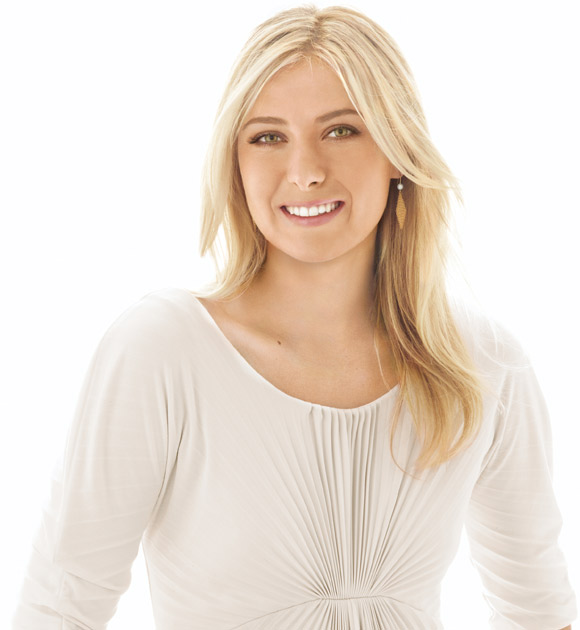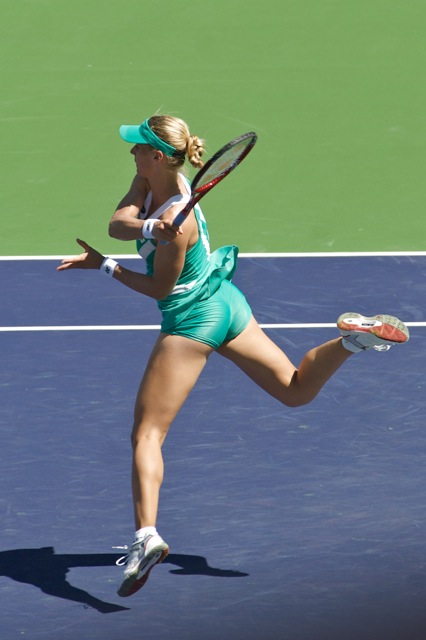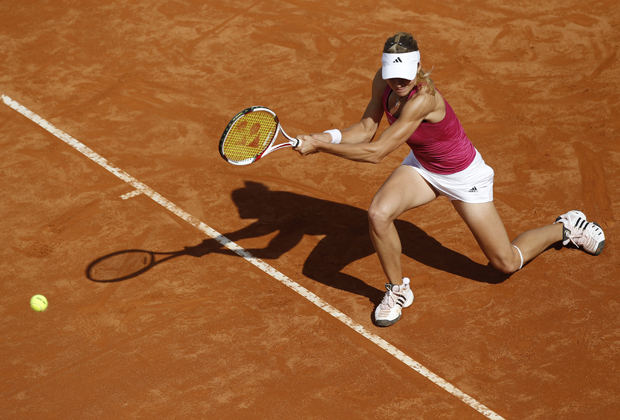B2D33BA1-5E47-4941-9AAF-D163D8EDC0FD
By Richard Pagliaro
Photo Credits: Andy Kentla, James White
(June 9, 2010) Six years ago, the childhood friends and practice partners walked out onto Court Philippe Chatrier making tracks through tennis history with each step they took.
Born three months and seven days apart in Moscow, Anastasia Myskina and Elena Dementieva both began playing tennis at about the age of seven in the same Moscow club and both were coached by Rauza Islanova, mother of Marat Safin and Dinara Safina and an influential designer of the Russian game, in their early years.
When the long-time friends faced off in the 2004 French Open final they made history in creating the first all-Russian final in Grand Slam history. Dementieva and Myskina were the first Russian women to reach a major final since Olga Morozova, Dementieva's former coach, suffered successive setbacks to Chris Evert in the 1974 Roland Garros and Wimbledon finals. Belarusian Natasha Zvereva, who was annihilated, 6-0, 6-0, by Steffi Graf in the 1988 Roland Garros final, represented the Soviet Union.
The 22-year-old Myskina dispatched a nervous Dementieva, who committed 10 double faults, 6-1, 6-2, to become the first Russian woman to win a major singles championship.
The feisty Myskina played tenacious tennis in fighting off a match point against 11th-seeded compatriot Svetlana Kuznetsova to register a 1-6, 6-4, 8-6 fourth-round victory and became the first woman since Margaret Court in 1962 to reign as Roland Garros champion after fighting off a match point earlier in the tournament.
That marked the beginning of a Russian rise on the WTA Tour that saw 17-year-old precocious power merchant Maria Sharapova shove Serena Williams aside at Wimbledon in dethroning the defending champion, 6-1, 6-4, to capture the 2004 Wimbledon crown.

Russian results spiked again three months later when the 19-year-old Kuznetsova conquered Dementieva, 6-3, 7-5, to win her first career Grand Slam title at the 2004 US Open.
Three consecutive majors, three straight Russian champions and all three were under the age of 23.
How rare was that Russian three-peat?
The last time one nation produced three different Grand Slam champions in a single season came a quarter-century earlier when Americans Barbara Jordan (Australian Open), Chris Evert (Roland Garros) and Tracy Austin (U.S. Open) combined to do it in 1979.
Two days after Kuznetsova's US Open victory, five Russian women — Dementieva, Kuznetsova, Myskina, Sharapova and Vera Zvonareva — resided in the WTA Tour Top 10. As recently as two year ago half of the WTA Tour's 2008 season-ending top 10 — No. 3 Dinara Safina, No. 4 Dementieva, No. 7 Zvonareva, No. 8 Kuznetsova and No. 9 Maria Sharapova — represented the Russian flag.
Factor in the fact that former Russian President Boris Yeltsin was an active cheerleader for the Russian women, often showing up court-side at their matches, and that Yeltsin's trusted adviser, Russian Davis Cup and Fed Cup captain Shamil Tarpischev, led the Russian Fed Cup team to four championships (2004, 2005, 2007 and 2008) in a five-year span and you had all the elements in place for a dynasty of dominance that seemed on course to span the rest of the decade.
Fast forward to today and Dementieva, who may have just seen her last best shot for a Grand Slam crown dissipate in the dust of Roland Garros when she retired from the French Open semifinals with what she called a torn calf muscle after losing the first-set tie breaker to eventual-champ Francesca Schiavone, stands as the only Russian women ranked in the top 10.
That story line of success has suddenly been as drastically altered as a Dostoevsky novel suddenly hijacked by Dr. Seuss in mid-sentence.
What happened? Where did all the Russians go? And will they ever return in full force to the top 10 again?

First and foremost, it's important to remember that tennis is cyclical and you need to look no further than the returns of Kim Clijsters and Justine Henin in recent months to realize resurgence can come in a matter of a few tournaments.
The beauty of tennis is that just when cynics put your career on life support, a major title can serve as a tennis defibrillator sparking your back to life. Remember just a few years ago, some players, media and fans had written off the Williams sisters careers as on the wane. Serena and Venus now stand at No. 1 and No. 2 in the world a full seven years after the sisters last occupied the top two spots in the rankings.
The difference of course is the Williams sisters have combined to claim 19 Grand Slam singles titles which dwarfs the combined major singles championships produced by all all of the aforementioned Russian women (Sharapova owns three majors, Kuznetsova has won two and Myskina won one before calling it quits).
Why have the Russian women slumped?
There is no one-size fits all excuse for the recent state of Russian women's tennis, but the most common reasons for the recent decline are injury (Sharapova, Safina, Zvonareva and Nadia Petrova have all spent time sideline in recent years due to an assortment of injuries), mental fragility that in come cases can be traced to over playing (see Safina, Dementieva and Kuznetsova) and in some cases one-note power-based baseline styles that are too predictable, lack the variety and margin for error that even younger players like Agnieszka Radwanska and Caroline Wozniacki show and a building frustration that sometimes manifests itself as a malaise.
"Russians are different than Americans," Dementieva told Tennis Now earlier this year. "In America, people seem more open, more friendly at times. In Russia, struggle is almost a part of life. We are used to these struggles."
The "I struggle, therefore I am" approach is one reason why Russians once resided in the top 10 en mass — many displayed that devoted work ethic and willingness to persevere through pain and problems — but at the most critical moments of a major match inner struggle can be a tough opponent to tame. In recent years, Safina, Dementieva, Zvonareva and Kuznetsova have all displayed emotional eruptions during Grand Slam play that bordered on melt downs.
Despite their departure from the top 10, it would be foolish to discard the Russians particularly given the encouraging results some posted at Roland Garros and the fact that several Russian women have a history of positive results at Wimbledon and the US Open where they fast, flat style of play typically translates fluently to the grass and Deco Turf.
Here is a look at the top 20 Russians and their prospects for the immediate future.
No. 5 Elena Dementieva — Typically, one of the fittest of all players, Dementieva has come close to breaking through and winning an elusive major twice in the last 12 months. She has reached three Grand Slam semifinals in her last six major starts, holding a match point against eventual-champ Serena before bowing, 6-7, 7-5, 8-6 in the 2009 Wimbledon semis in one of the best performances of her carer, and up a break in the French Open semis before folding against Schiavone with injury at the French Open. Dementieva is arguably the most balanced off both forehand and backhand (though her forehand is her strength) of any Russian women, she's worked diligently to improve her once sling-shot slice serve and she's made inroads into majors in recent months. Like many Russians, she lacks variety in her game, she does not use her net skills nearly as much as she could and ultimately has not shown the strong sense of self belief required to master a major. The clock is ticking on her Grand Slam title hopes, but if she stays healthy she should be a top 10 mainstay.
No. 13 Nadia Petrova — Her game is built around her strong serve and bold backhand, Petrova showed she's still a a major threat in beating Aravane Rezai and Venus Williams before falling to Dementieva in the French Open quarters. A capable player on all surfaces, her conditioning remains a question mark, her forehand can go awry and while the woman who celebrated her 28th birthday yesterday may never win a singles major, she can return to the top 10.
No. 17 Maria Sharapova — The fiercest fighter of all the Russians, Sharapova, who has spent much of her life in the United States, has returned from shoulder surgery to show flashes of the form that made her a former World No. 1. Given the state of her shoulder and her skittish serve it appears unlikely Sharapova will ever regain and hold the top spot for any length of time (not that she isn't capable from a playing standpoint, just that her body has betrayed her in recent years and it's questionable if she could sustain a schedule necessary to hold down the top spot), but you can't write her off as a major title contender. Sharapova not only knows how to win, she gets up for major matches (see her performance vs. Justine Henin at the French Open) and is the best competitor of all the Russians. Still, it's mind-blowing that at 6-foot-2, the three-time Grand Slam champion cannot master a kick serve. Watch Sharapova practice and she sometimes has trouble clearing the net with her flat serve. If you could infuse Samantha Stosur's serve onto Sharapova's game, she could master virtually any major (with the possible exception of the only one she hasn't won, Roland Garros), but if you could add Stosur's serve to Dementieva's game she could win a major as well. The other issue is that the bigger hitters, like the Williams sisters, move better than Sharapova and Serena, in particular, has been effective in breaking down Sharapova's flat forehand.
No. 19 Svetlana Kuznetsova — The Russian most likely to rise up and win a major — or suffer a first-round meltdown. Kuznetsova owns the most complete game of all the Russians, the problem is she sometimes looks like she has no clue how to use it. Mentally, Kuznetsova can be so fragile she makes Marat Safin look like Bjorn Borg in comparison. IF Kuznetsova can get her head straight, settle on a game plan and just play without looking like she's about to burn her brain cells with a blow torch after every error, she should win at least one more major in her career. She's never been No. 1 and given her mental state it's unlikely she would thrive at the top as Kuznetsova, like Safin, always seems to perform her best when expectations are least. Still, she's had some of her best results at the US Open and could be a factor there.
No. 20 Dinara Safina — The former World No. 1 admits playing is painful and watching her implode can be pure tennis torture. Safina said in Stuttgart her back injury could be career-threatening. She sat out three months after retiring from her Australian Open match against Maria Kirilenko and still looks like she's suffering on court. Safina would be best served by taking some time off to heal her body, mind and spirit. Rarely has a No. 1 player looked so unhappy on court. Safina must learn to play from a place of love and joy rather than than operating out of the pain and fear so prevalent in her game in recent months.
Regardless of how the rest of the season plays out for these players, there is hope for other Russians. Alisa Kleybanova, who has wins over former World No. 1 players Venus Williams, Ana Ivanovic and Kim Clijsters (at Indian Wells) is an intelligent talent who is more athletic than she looks and whose unorthodox game can pose problems for even top players.
Consistency continues to be an issue for Kleybanova. The World No. 27 pushed Henin to three sets at the Australian Open and beat Dementieva to win Kuala Lumpur, but has suffered losses to players ranked outside the top 40.

Kirilenko has also had her moments, with some coming against her compatriots. She reached her first major quarterfinal in January after Safina retired from their fourth-round match, scored clay-court wins over Kuznetsova in Rome and Roland Garros and is currently ranked No. 28 following her run to the Roland Garros round of 16 where she lost to Schiavone. Kirilenko is an accomplished doubles player, who often uses the entire court more effectively than her compatriots, can compete on any surface, but at 5-foot-8, 123 pounds the slender Moscow native is at a strength disparity and lacks the kill shot to consistently threaten the game's premier power players. Still, her style is among the most aesthetically pleasing of all the Russians and at 23 her best tennis should still be ahead.
The 20-year-old Kleybanova and her friend and sometime practice partner, 19-year-old Anastasia Pavlyuchenkova give Russia two young potential top 15 players, who are both currently ranked in the top 30. Kleybanova says playing under the Russian flag brings greater expectations and cautions the pipeline that has produced so many top 20 players in recent years may not quite flow as freely in the near future.
"If you're from Russia, when you go out on the court, everybody's a bit like, you know, expecting something great from you," Kleybanova said. "I'm happy that we're actually together coming up, because, you know, there are so many good Russians still on top of us and not so many young ones coming. You know, they are still there, the elite group, and I'm happy that she's the one to join me to go forward, because it's always better to have more from our country, you know. Of course we compete against each other, you know. Obviously we have a competition between us when you have so many Russian players. You always want to be better than the others."